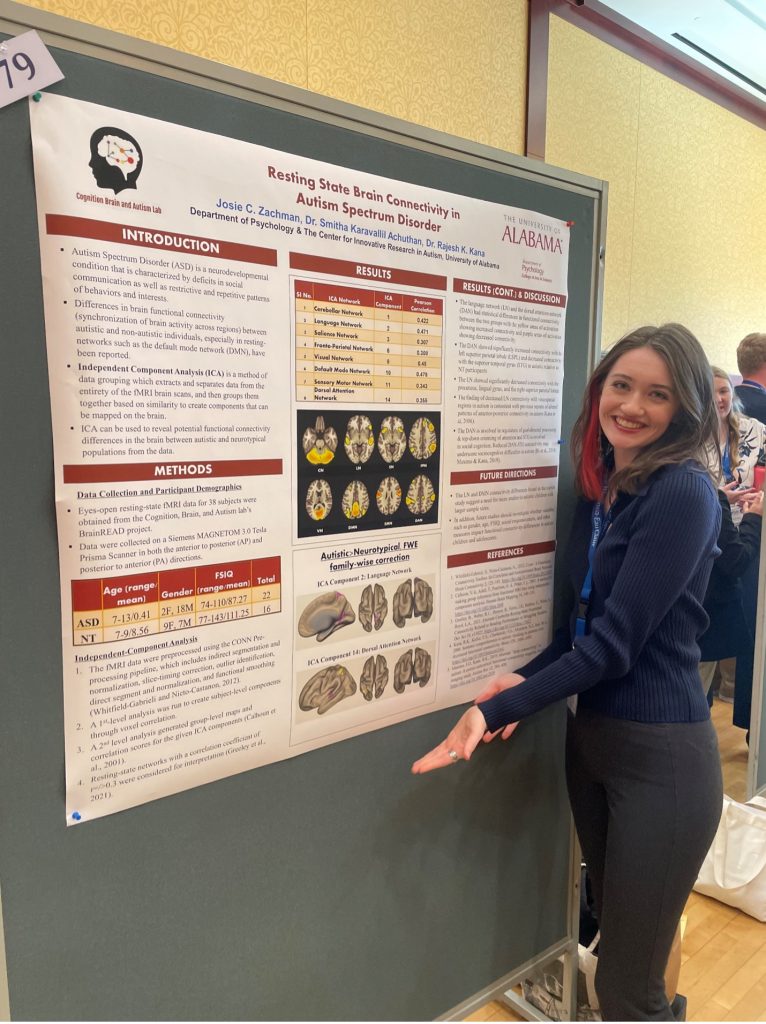This ASSURE Program story showcases the incredible journey of Josie Zachman, a dedicated researcher whose investigation into neurological differences between autistic and neurotypical subjects yielded insightful findings. Guided by the support of her mentor, Dr. Rajesh Kana, and fellow researcher, Dr. Smitha Karavallil Achuthan, Josie embarked on a rigorous investigation utilizing fMRI data analysis techniques. Through the financial assistance provided by the ASSURE grant, Josie not only conducted groundbreaking research but also presented her findings at prestigious conferences, further contributing to the scientific community. Her experience demonstrates the transformative impact of the ASSURE program in empowering aspiring researchers to pursue innovative projects and advance knowledge in their respective fields.

Before applying to the ASSURE program, I had been in Dr. Rajesh Kana’s research lab for almost a year. Having developed a good sense of the research processes and conditions of the lab, I was able to start formulating a new, big project. To help, Dr. Kana suggested I apply for the ASSURE grant, which I had not yet heard of. After reading through the grant proposal guidelines and talking to another lab member who had received the grant the year before, I was quite eager to formulate my proposal for my upcoming project.
As a general overview, my research focused on neurological differences in fMRI data between autistic and neurotypical subjects through an independent component analysis. Using pre-recorded fMRI data from the Cognition, Brain, and Autism’s BrainREAD project, I was able to upload information into CONN, a neuroimaging analysis software. From there, I went through a rigorous data cleaning process and put it through an independent component analysis, which finds specific brain networks that may have functional differences between the two groups. After completing this process, I was able to find a few key differences in major brain networks between the two groups. After this finding, I continued to run additional analyses on the data as more subject fMRI scans came in, allowing for a greater sample size and a more complete overview of the differences. Though this process was time-consuming and tedious at times, I learned a great deal about neuroimaging processing and localization of brain networks.
As the research concluded, I had found a few key findings. My ICA analysis came up with eight statistically significant networks, including the cerebellar network, the language network, the salience network, the frontoparietal network, the visual network, the default-mode network, the sensory-motor network, and the dorsal attention network. Out of these eight networks, there were two with statistically significant differences between the autistic and neurotypical groups: the language network and the dorsal attention network. The language network showed two regions of lower connectivity, while the dorsal attention network showed one area of higher connectivity and one area of lower connectivity. While primitive, these results coincide with current research that suggests differences in these same networks. More research must be done to increase validity across different populations, but this research is a good start on where to look and what variables to include for the next analysis.
I was able to write my results into an abstract that was accepted to both the URCA conference, as well as the National Conference for Undergraduate Research (NCUR). I created a poster and presented at both conferences in April 2023, traveling up to Eau Claire, Wisconsin for the NCUR conference.
The financial help from the ASSURE grant was imperative in my attendance at both conferences. I used the funding to get my posters printed, as well as to pay for the abstract submission fees. Without the funding of the grant, I would not have been able to travel to the national conference to present my research to my peers. It was a truly incredible experience that I will not forget, and I am very thankful that my research was chosen as an awardee for the grant.
Throughout this entire procedure, both Dr. Kana and a postdoctoral fellow, Dr. Smitha Karavallil Achuthan, supported me through the learning process. They provided me with the informational resources that I needed to complete the project, as well as continued support in revising, editing, and reviewing documents. Their support made it so that I was able to complete this feat and was able to further help other lab members in similar endeavors. I would highly recommend other students to apply for the ASSURE program and in fact I strongly suggested my good friend to apply, and she was awarded the ASSURE funding in Fall 2023. The ASSURE grant provided resources that allowed me to take my research much farther than I would have been able to on my own, and I am confident that it would similarly help other students.